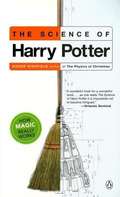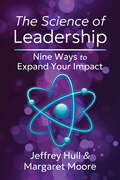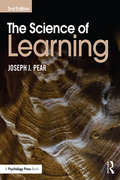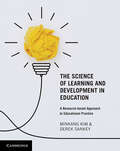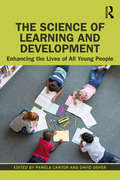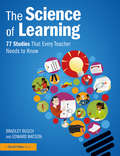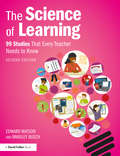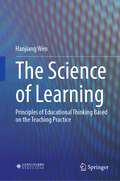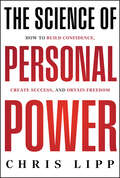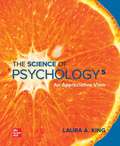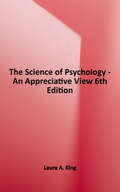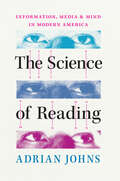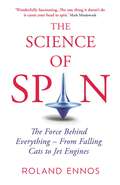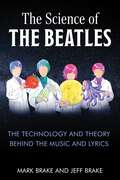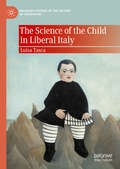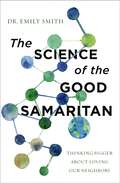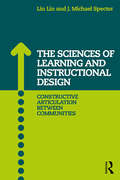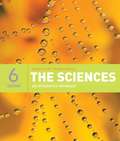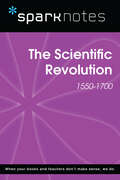- Table View
- List View
The Science of Harry Potter
by Roger HighfieldCan Fluffy the three-headed dog be explained by advances in molecular biology? Could the discovery of cosmic "gravity-shielding effects" unlock the secret to the Nimbus 2000 broomstick's ability to fly? Is the griffin really none other than the dinosaur Protoceratops? Roger Highfield, author of the critically acclaimed The Physics of Christmas, explores the fascinating links between magic and science to reveal that much of what strikes us as supremely strange in the Potter books can actually be explained by the conjurings of the scientific mind. This is the perfect guide for parents who want to teach their children science through their favorite adventures as well as for the millions of adult fans of the series intrigued by its marvels and mysteries.
The Science of Higher Education: State Higher Education Policy and the Laws of Scale
by Mario C. MartinezPerennial conclusions from state-by-state funding-per-student analyses of underfunding and weak state commitment have become so common that they have diluted the potency of the argument to state policymakers for more higher education funding. In addition, there has been little in the way of testing or questioning the assumptions embedded in traditional funding per student analysis and its accompanying conclusions.As state legislators balance the competing needs of education, health, transportation, and public safety budgets, they increasingly ask what return on investment (ROI) they get for the funding they provide, including from higher education. The ROI language, while potentially unsettling for its corporate-like and neoliberal connotation, will persist into the foreseeable future. We must ask questions both of adequacy (How much funding should the states provide?) and benefit (What benefits do states receive for the higher education funding they provide?). The focus on traditional funding per student analysis has remained static for over forty years, indicating the need for new ideas and methods to probe questions of adequacy and benefit.The Science of Higher Education is an introduction to a new paradigm that explores state higher education funding, enrollment, completion, and supply (the number and type of institutions in a state) through the lens of what are commonly known as power laws. Power laws explain patterns in biological systems and characteristics of cities. Like cities, state higher education systems are complex adaptive systems, so it is little surprise that power laws also explain funding, enrollment, completion, and supply.The scale relationships uncovered in the Science of Higher Education suggest the potential benefits state policymakers could derive by emphasizing enrollment, completion, or capacity policies, based on economies of scale, marginal benefits, and the return state’s get on enrollment and completion for the funding they provide.The various features of state higher education systems that conform to scale patterns do not alone provide definitive answers for appropriate funding levels, however. As this book addresses, policymakers need to take into account the macro forces, from demography to geography and the economy, that situate the system, as well the interactions between government and market actors that are at the core of every state higher education system and influence the outcomes it achieves.
The Science of Leadership: Nine Ways to Expand Your Impact
by Margaret Moore Jeffrey HullAt last, everyday leaders can put the science of leadership into action every day to model, inspire, and empower others to perform at their best.The Science of Leadership: Nine Ways to Expand Your Impact presents a game-changing synthesis of 50 years of leadership research as a comprehensive guide for seasoned and aspiring leaders, and anyone who wants to help their boss become a better leader.Authors Jeffrey Hull and Margaret Moore, leadership coaches and leaders of the Institute of Coaching, translate academic research and their extensive experience in leading and coaching into a practical, self-coaching roadmap for your own growth in these times of exponential change and disruption.This book organizes the science of leadership (15,000+ studies and articles showing what improves individual, team, and organizational performance) into nine capacities which build upon each other. Each capacity is brought to life by real-life stories, a science overview, practices, and ways to deal with overuse. These capacities are organized into three levels with increasing complexity:Self-Oriented1. Conscious - See clearly, including myself2. Authentic - Care3. Agile - FlexOther-Oriented4. Relational - Help5. Positive - Strengthen6. Compassionate - ResonateSystem-Oriented (team and organization)7. Shared - Share8. Servant - Serve9. Transformational - TransformWhether you're a C-suite executive, an emerging leader, or a professional coach or consultant, The Science of Leadership delivers the fundamentals you need to know. You will quiet your ego and feel more fulfilled as a leader as your impact grows. Leading will feel more like flying than trudging uphill, with more ease, less strain, and more pleasure.
The Science of Learning
by Joseph J. PearFor over a century and a quarter, the science of learning has expanded at an increasing rate and has achieved the status of a mature science. It has developed powerful methodologies and applications. The rise of this science has been so swift that other learning texts often overlook the fact that, like other mature sciences, the science of learning has developed a large body of knowledge. The Science of Learning comprehensively covers this knowledge in a readable and highly systematic manner. Methodology and application are discussed when relevant; however, these aspects are better appreciated after the reader has a firm grasp of the scientific knowledge of learning processes. Accordingly, the book begins with the most fundamental and well-established principles of the science and builds on the preceding material toward greater complexity. The connections of the material with other sciences, especially its sister science, biology, are referenced throughout. Through these frequent references to biology and evolution, the book keeps in the forefront the recognition that the principles of learning apply to all animals. Thus, in the final section the book brings together all learning principles studied in research settings by demonstrating their relevance to both animals and humans in their natural settings. For animals this is the untamed environment of their niches; for humans it is any social environment, for Homo sapiens is the social and learning animal par excellence.
The Science of Learning and Development in Education: A Research-based Approach to Educational Practice
by Minkang Kim Derek SankeyAll teachers need to know how children and adolescents learn and develop. Traditionally, this knowledge had been informed by a mix of speculative and scientific theory. However, in the past three decades there has been substantial growth in new scientific knowledge about how we learn. The Science of Learning and Development in Education provides an exciting and comprehensive introduction to this field. This innovative text introduces readers to brain science and the science of complex systems as it applies to human development. Section 1 examines the science of learning and development in the 21st century; Section 2 explores the emotional, cultural, moral and empathetic brain; and Section 3 focuses on learning, wellbeing and the ecology of learning environments. Written in an engaging style by leading experts and generously illustrated with colour photographs and diagrams, The Science of Learning and Development in Education is an essential resource for pre-service teachers.
The Science of Learning and Development: Enhancing the Lives of All Young People
by Pamela Cantor; David OsherThis essential text unpacks major transformations in the study of learning and human development and provides evidence for how science can inform innovation in the design of settings, policies, practice, and research to enhance the life path, opportunity and prosperity of every child. The ideas presented provide researchers and educators with a rationale for focusing on the specific pathways and developmental patterns that may lead a specific child, with a specific family, school, and community, to prosper in school and in life. Expanding key published articles and expert commentary, the book explores a profound evolution in thinking that integrates findings from psychology with biology through sociology, education, law, and history with an emphasis on institutionalized inequities and disparate outcomes and how to address them. It points toward possible solutions through an understanding of and addressing the dynamic relations between a child and the contexts within which he or she lives, offering all researchers of human development and education a new way to understand and promote healthy development and learning for diverse, specific youth regardless of race, socioeconomic status, or history of adversity, challenge, or trauma. The book brings together scholars and practitioners from the biological/medical sciences, the social and behavioral sciences, educational science, and fields of law and social and educational policy. It provides an invaluable and unique resource for understanding the bases and status of the new science, and presents a roadmap for progress that will frame progress for at least the next decade and perhaps beyond.
The Science of Learning: 77 Studies That Every Teacher Needs to Know
by Edward Watson Bradley BuschSupporting teachers in the quest to help students learn as effectively and efficiently as possible, The Science of Learning translates 77 of the most important and influential studies on the topic of learning into accessible and easily digestible overviews. Demystifying key concepts and translating research into practical advice for the classroom, this unique resource will increase teachers’ understanding of crucial psychological research so they can help students improve how they think, feel and behave in school. From large to- small-scale studies, from the quirky to the iconic, The Science of Learning breaks down complicated research to provide teachers with the need-to-know facts and implications of each study. Each overview combines graphics and text, asks key questions, describes related research and considers implications for practice. Highly accessible, each overview is attributed to one of seven key categories: Memory: increasing how much students remember Mindset, motivation and resilience: improving persistence, effort and attitude Self-regulation and metacognition: helping students to think clearly and consistently Student behaviours: encouraging positive student habits and processes Teacher attitudes, expectations and behaviours: adopting positive classroom practices Parents: how parents’ choices and behaviours impact their childrens’ learning Thinking biases: avoiding faulty thinking habits that get in the way of learning A hugely accessible resource, this unique book will support, inspire and inform teaching staff, parents and students, and those involved in leadership and CPD.
The Science of Learning: 99 Studies That Every Teacher Needs to Know
by Edward Watson Bradley BuschSupporting teachers in the quest to help students learn as effectively and efficiently as possible, The Science of Learning translates 99 of the most important and influential studies on the topic of learning into accessible and easily digestible overviews. Building on the bestselling original book, this second edition delves deeper into the world of research into what helps students learn, with 22 new studies covering key issues including cognitive-load theory, well-being and performing well under exam pressure. Demystifying key concepts and translating research into practical advice for the classroom, this unique resource will increase teachers’ understanding of crucial psychological research so they can help students improve how they think, feel and behave in school. From large- to small-scale studies, from the quirky to the iconic, the book breaks down complicated research to provide teachers with the need-to-know facts and implications of each study. Each overview combines graphics and text, asks key questions, describes related research and considers implications for practice. Highly accessible, each overview is attributed to one of seven key categories: Memory: increasing how much students remember Mindset, motivation and resilience: improving persistence, effort and attitude Self-regulation and metacognition: helping students to think clearly and consistently Student behaviours: encouraging positive student habits and processes Teacher attitudes, expectations and behaviours: adopting positive classroom practices Parents: how parents’ choices and behaviours impact their childrens’ learning Thinking biases: avoiding faulty thinking habits that get in the way of learning A hugely accessible resource, this unique book will support, inspire and inform teaching staff, parents and students, and those involved in leadership and CPD.
The Science of Learning: Principles of Educational Thinking Based on the Teaching Practice
by Hanjiang WenThis book systematically summarizes the author's more than 30 years of experience in teaching reform and educational research. The book is divided into three parts. Part I focuses on the comprehensiveness of thinking and the relationship between the coordinated development of thinking and the overall development of human beings. Part II and Part III mainly discuss the six basic principles of learning and thinking: the principle of the working memory of thinking, the principle of learning transfer, the principle of the basic process of learning, the principle of multi-level development of ability, the principle of sustainable development of learning, and the principle of subjectivity of learning.This book features the rules and characteristics of student learning with a student-centered approach, which can help teachers and educational researchers to better understand students and provide theoretical guidance for students’ all-round development.
The Science of Personal Power: How to Build Confidence, Create Success, and Obtain Freedom
by Chris LippUnlock the door to personal power, happiness, achievement, and strength in any situation In The Science of Personal Power, renowned professor and persuasion expert Chris Lipp reveals how to bridge the science of inner well-being with the science of outer achievement by developing personal power—a concept that, when put into practice, is a panacea for both happiness and success. Unlike formal power, which focuses on authority and control, personal power is about how we feel about our own capability to create impact. When we feel big, we show up big, and when we show up big, we can change the world. This book offers a transformative approach to completely revamp every aspect of your life, starting with your present mindset and extending to long-term career advancement, financial success, and beyond. Enhanced Self-Confidence: Learn how to feel more capable and impactful in your daily life. Practical Tools for Success: Gain actionable strategies and tips to improve your personal and professional life. Increased Influence: Discover how to effectively influence others and drive positive change. The Science of Personal Power combines research, data, and storytelling to help you understand foundational concepts related to psychology and business. It highlights counter-intuitive discoveries and reconciles conflicting findings to provide practical tips, strategies, and approaches to enhance personal power and influence others. This book is designed for anyone looking to rise above personal obstacles and societal barriers to become the most powerful version of themselves. Ready to transform your life from the inside out? Tap into your personal power and start your journey towards happiness and success with The Science of Personal Power today.
The Science of Psychology (Third Edition)
by Laura A. KingFocusing on why things go right, The Science of Psychology: An Appreciative View, Third Edition, helps students understand and appreciate psychology as a science and as an integrated whole. The third edition's program extends the themes and enhances the pedagogical value by guiding students toward topics they find the most challenging and then offering new learning resources to help students master them.
The Science of Psychology: An Appreciative View
by Laura A. KingThis book communicates the nature and breadth of psychology -and its value as a science - with an emphasis on why things go right. With primary goals of teaching students to think like psychological scientists and focusing on the understanding of human strengths and capacities, health, and wellness, the book cultivates students’ appreciation for how extensively psychology applies to their lives.
The Science of Psychology: An Appreciative View, 6th Edition
by Laura A. KingFocusing on why things go right, The Science of Psychology: An Appreciative View helps students understand and appreciate psychology as a science and as an integrated whole. Informed by student data, the program extends these themes and enhances their pedagogical value by helping students through topics they find the most challenging and offering learning resources to master them. With a deep integration of cultural diversity, the text offers a “Guide to Diversity, Equity, and Inclusion” in the Preface, providing a chapter-by-chapter list of topics involving DEI issues and research. When paired with Connect, students will also benefit from Thematic Relevancy Modules (brief, thought-provoking modules tied to the APA's IPI Student Learning Outcomes), Interactivities and Application-Based-Activities, Psych-at-Work videos (interviews with real people), the new and unique Immersive Brain, and more innovative resources to help further prepare them to be successful in this course.
The Science of Reading
by Charles Hulme Margaret J. SnowlingThe Science of Reading: A Handbook brings together state-of-the-art reviews of reading research from leading names in the field, to create a highly authoritative, multidisciplinary overview of contemporary knowledge about reading and related skills.Provides comprehensive coverage of the subject, including theoretical approaches, reading processes, stage models of reading, cross-linguistic studies of reading, reading difficulties, the biology of reading, and reading instruction Divided into seven sections:Word Recognition Processes in Reading; Learning to Read and Spell; Reading Comprehension; Reading in Different Languages; Disorders of Reading and Spelling; Biological Bases of Reading; Teaching Reading Edited by well-respected senior figures in the field
The Science of Reading: A Handbook (Wiley Blackwell Handbooks of Developmental Psychology #9)
by Charles Hulme Margaret J. Snowling Kate NationProvides an overview of state-of-the-art research on the science of reading, revised and updated throughout The Science of Reading presents the most recent advances in the study of reading and related skills. Bringing together contributions from a multidisciplinary team of experts, this comprehensive volume reviews theoretical approaches, stage models of reading, cross-linguistic studies of reading, reading instruction, the neurobiology of reading, and more. Divided into six parts, the book explores word recognition processes in skilled reading, learning to read and spell, reading comprehension and its development, reading and writing in different languages, developmental and acquired reading disorders, and the social, biological, and environmental factors of literacy. The second edition of The Science of Reading is extensively revised to reflect contemporary theoretical insights and methodological advances. Two entirely new chapters on co-occurrence and complexity are accompanied by reviews of recent findings and discussion of future trends and research directions. Updated chapters cover the development of reading and language in preschools, the social correlates of reading, experimental research on sentence processing, learning to read in alphabetic orthographies, comorbidities that occur frequently with dyslexia, and other central topics. Demonstrates how different knowledge sources underpin reading processes using a wide range of methodologies Presents critical appraisals of theoretical and computational models of word recognition and evidence-based research on reading intervention Reviews evidence on skilled visual word recognition, the role of phonology, methods for identifying dyslexia, and the molecular genetics of reading and language Highlights the importance of language as a foundation for literacy and as a risk factor for developmental dyslexia and other reading disorders Discusses learning to read in different types of writing systems, with a language impairment, and in variations of the home literacy environment Describes the role of contemporary analytical tools such as dominance analysis and quantile regression in modelling the development of reading and comprehensionPart of the acclaimed Wiley Blackwell Handbooks of Developmental Psychology series, the second edition of The Science of Reading: A Handbook remains an invaluable resource for advanced students, researchers, and specialist educators looking for an up-to-date overview of the field.
The Science of Reading: Information, Media, and Mind in Modern America
by Adrian JohnsFor the first time, the story of how and why we have plumbed the mysteries of reading, and why it matters today. Reading is perhaps the essential practice of modern civilization. For centuries, it has been seen as key to both personal fulfillment and social progress, and millions today depend on it to participate fully in our society. Yet, at its heart, reading is a surprisingly elusive practice. This book tells for the first time the story of how American scientists and others have sought to understand reading, and, by understanding it, to improve how people do it. Starting around 1900, researchers—convinced of the urgent need to comprehend a practice central to industrial democracy—began to devise instruments and experiments to investigate what happened to people when they read. They traced how a good reader’s eyes moved across a page of printed characters, and they asked how their mind apprehended meanings as they did so. In schools across the country, millions of Americans learned to read through the application of this science of reading. At the same time, workers fanned out across the land to extend the science of reading into the social realm, mapping the very geography of information for the first time. Their pioneering efforts revealed that the nation’s most pressing problems were rooted in drastic informational inequities, between North and South, city and country, and white and Black—and they suggested ways to tackle those problems. Today, much of how we experience our information society reflects the influence of these enterprises. This book explains both how the science of reading shaped our age and why, with so-called reading wars still plaguing schools across the nation, it remains bitterly contested.
The Science of Reading: Information, Media, and Mind in Modern America
by Adrian JohnsFor the first time, the story of how and why we have plumbed the mysteries of reading, and why it matters today. Reading is perhaps the essential practice of modern civilization. For centuries, it has been seen as key to both personal fulfillment and social progress, and millions today depend on it to participate fully in our society. Yet, at its heart, reading is a surprisingly elusive practice. This book tells for the first time the story of how American scientists and others have sought to understand reading, and, by understanding it, to improve how people do it. Starting around 1900, researchers—convinced of the urgent need to comprehend a practice central to industrial democracy—began to devise instruments and experiments to investigate what happened to people when they read. They traced how a good reader’s eyes moved across a page of printed characters, and they asked how their mind apprehended meanings as they did so. In schools across the country, millions of Americans learned to read through the application of this science of reading. At the same time, workers fanned out across the land to extend the science of reading into the social realm, mapping the very geography of information for the first time. Their pioneering efforts revealed that the nation’s most pressing problems were rooted in drastic informational inequities, between North and South, city and country, and white and Black—and they suggested ways to tackle those problems. Today, much of how we experience our information society reflects the influence of these enterprises. This book explains both how the science of reading shaped our age and why, with so-called reading wars still plaguing schools across the nation, it remains bitterly contested.
The Science of Selling: Proven Strategies to Make Your Pitch, Influence Decisions, and Close the Deal
by David HoffeldThe Revolutionary Sales Approach Scientifically Proven to Dramatically Improve Your Sales and Business Success Did you know that nearly half of salespeople fail to meet their quotas every year? Or that many of the most common sales behaviors drive down sales performance? In today's fiercely competitive marketplace you can't afford to lose sales that should be yours. But with so much conflicting advice from self-proclaimed "gurus," how do you know which sales strategies actually work? Leading sales trainer, researcher and CEO of Hoffeld Group, David Hoffeld, has the answer. Blending cutting-edge research in social psychology, neuroscience, and behavioral economics, The Science of Selling shows you how to align the way you sell with how our brains naturally form buying decisions, dramatically increasing your ability to earn more sales. Unlike other sales books, which primarily rely on anecdotal evidence and unproven advice, Hoffeld's evidence-based approach connects the dots between science and situations salespeople and business leaders face every day to help you consistently succeed, including proven ways to: - Engage buyers' emotions to increase their receptiveness to you and your ideas - Ask questions that line up with how the brain discloses information - Lock in the incremental commitments that lead to a sale - Create positive influence and reduce the sway of competitors - Discover the underlying causes of objections and neutralize them - Guide buyers through the necessary mental steps to make purchasing decisions Packed with advice and anecdotes, The Science of Selling is an essential resource for anyone looking to succeed in today's cutthroat selling environment, advance their business goals, or boost their ability to influence others.From the Hardcover edition.
The Science of Spin: The Force Behind Everything – From Falling Cats to Jet Engines
by Roland EnnosWhy exactly is the Earth round? How is it that boomerangs can turn in mid-air? And why do cats always land on their feet? From the solar system to spinning tops; hurricanes to hula hoops; powerplants to pendulums, one mysterious force shapes almost every aspect of our lives. A force which, despite its ubiquity, continues to confound, baffle and surprise. Artfully moving between astrophysics and anthropology, The Science of Spin provides a sweeping journey through space and time, from the creation of the Earth to the advent of the &‘fidget spinner&’. Charting the development of engineering and technology from the earliest prehistoric drills to the turbine engine, critically acclaimed author and scientist Roland Ennos presents a riveting account of human ingenuity and the seemingly infinite ways spin affects our daily lives.
The Science of The Beatles: The Technology and Theory Behind the Music and Lyrics (The Science of)
by Mark Brake Dr. Jeff BrakeAn In-Depth Analysis of The Beatles' Music and the Theory, Techniques, and Technology That Made It Possible When people look back in two hundred years time at our culture, whose music will have survived from today? Who will be our equivalent of Bach, Mozart, and Beethoven? The big story of contemporary popular music has been The Beatles. They were the chief architects of the fusion of classical and popular music to create a new musical mainstream. From the time we humans first made our art, music and technology have been inseparable. And that symbiotic relationship has never been so excitingly orchestrated than with the musical history of The Beatles. They absorbed many other styles around them in an extraordinary and unprecedented melting pot of music. And they embraced new technologies with enthusiasm and imagination. As pioneers of recording tech and artistic presentation, making American music with a British twist, The Beatles revolutionized many aspects of music tech, and became leaders of the era&’s youth and sociocultural movements. Their music was both genuinely sophisticated and hugely popular. For a generation, they were the most important composers in the world, and became the most influential band of all time. Putting the band&’s thirteen legendary studio albums under a microscope, The Science of The Beatles looks at the science, poetry, and raw-power in the music that started a revolution.
The Science of the Child in Liberal Italy (Palgrave Studies in the History of Childhood)
by Luisa TascaThis book investigates a forgotten chapter of history: the role of Italian sciences within the child study movement. Between the 1880s and the First World War, children became the focus of unprecedented professional and scientific interest in Europe and the United States. The bodies and psyches of children, their care and growth, their development, 'normal' and 'abnormal', intelligence, and moral sense, constituted a new field of research. Italy, which had just become a nation, also took part in this international movement: on the study of the child, a substantial part of the Italian ruling class launched itself, with a mixture of enthusiasm, hope and concern, on the frontier between different areas of knowledge. Using a broad spectrum of sources, this book offers the first overview of the Italian scientific movement of child study.
The Science of the Good Samaritan: Thinking Bigger about Loving Our Neighbors
by Dr. Emily SmithWhat does it mean to love your neighbor in today's fraught, divided world?Join Dr. Emily Smith, global health expert and creator of the popular Facebook page Friendly Neighbor Epidemiologist, as she dives into what loving your neighbor--as illustrated in the biblical parable of the Good Samaritan--truly means. Combining Dr. Smith's expertise as a scientist with her deep Christian faith while drawing from her journey from small-town Texas to a prestigious university, The Science of the Good Samaritan shares fascinating stories from Dr. Smith's life and the lives of other inspiring people around the world to show us how to:Find shared values with people from different backgrounds, faiths, and cultures than our ownReach outside our immediate circles to bring in those on the marginsRedefine our concept of "neighbor" and love our neighbors in more practical and global waysBridge the gaps of society's disparities and inequitiesYou can help reimagine and create a better world--and it all starts with authentically loving your neighbor.
The Sciences of Learning and Instructional Design: Constructive Articulation Between Communities
by J. Michael Spector Lin LinThere are two distinct professional communities that share an interest in using innovative approaches and emerging technologies to design and implement effective support for learning. This edited collection addresses the growing divide between the learning sciences community and the instructional design and technology community, bringing leading scholars from both fields together in one volume in an attempt to find productive middle ground. Chapters discuss the implications of not bridging this divide, propose possible resolutions, and go on to lay a foundation for continued discourse in this important area.
The Sciences: An Integrated Approach (Sixth Edition)
by James Trefil Robert M. HazenOver 100,000 readers have relied on Trefil to gain a better understanding of physics, chemistry, astronomy, earth sciences, and biology. The book focuses on the great ideas in each field while showing readers how core scientific principles connect to their daily lives. The sixth edition emphasizes important themes and relationships, along with new real world connections. Scientific American has been added to the book along with completely updated examples. The presentation also employs a more visual approach that includes new illustrations and visuals. In addition, new problems help readers answer the big questions in science.
The Scientific Revolution (SparkNotes History Notes)
by SparkNotesThe Scientific Revolution (1550-1700) (SparkNotes History Note) Making the reading experience fun! SparkNotes History Guides help students strengthen their grasp of history by focusing on individual eras or episodes in U.S. or world history. Breaking history up into digestible lessons, the History Guides make it easier for students to see how events, figures, movements, and trends interrelate. SparkNotes History Guides are perfect for high school and college history classes, for students studying for History AP Test or SAT Subject Tests, and simply as general reference tools.Each note contains a general overview of historical context, a concise summary of events, lists of key people and terms, in-depth summary and analysis with timelines, study questions and suggested essay topics, and a 50-question review quiz.
